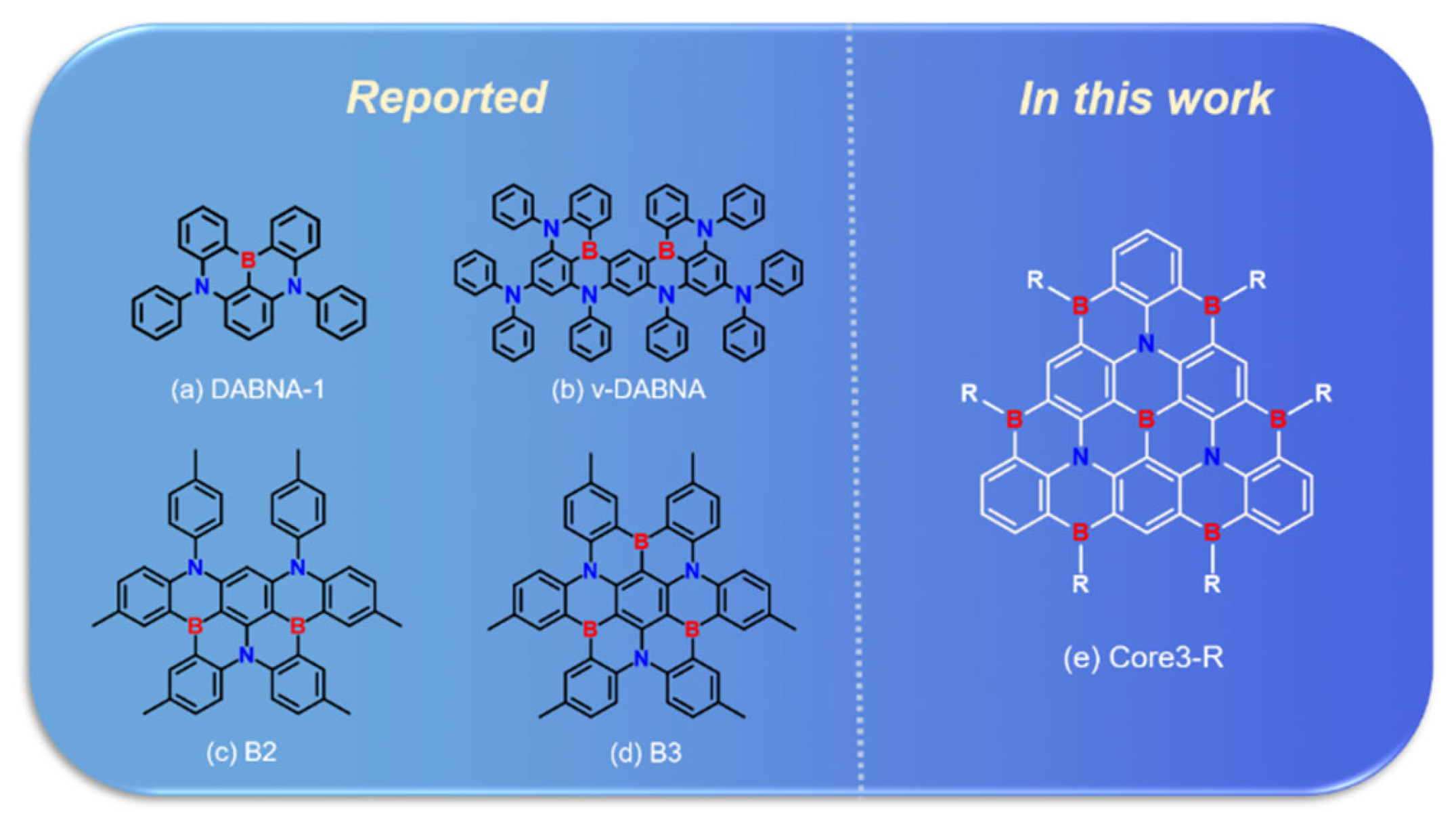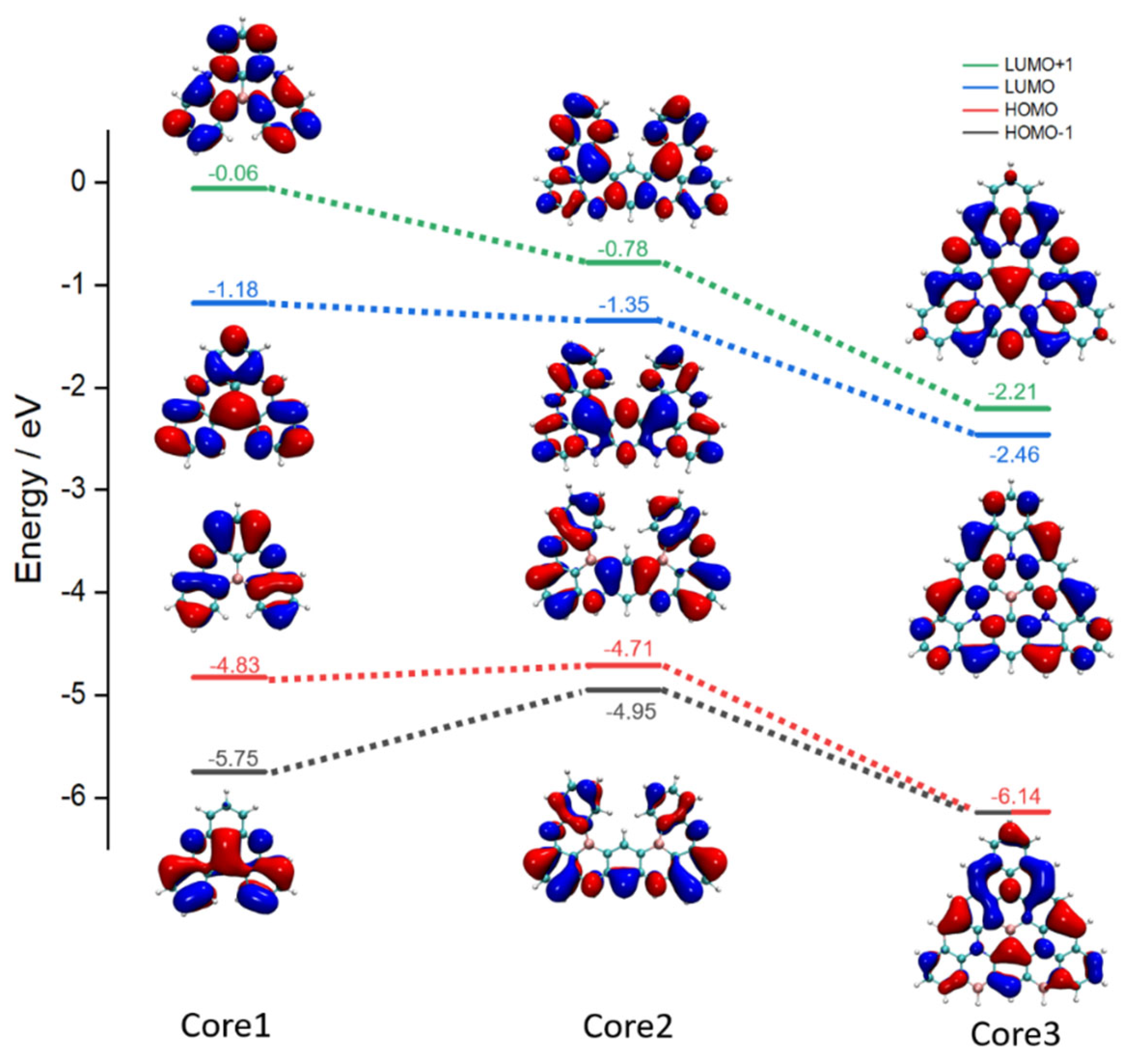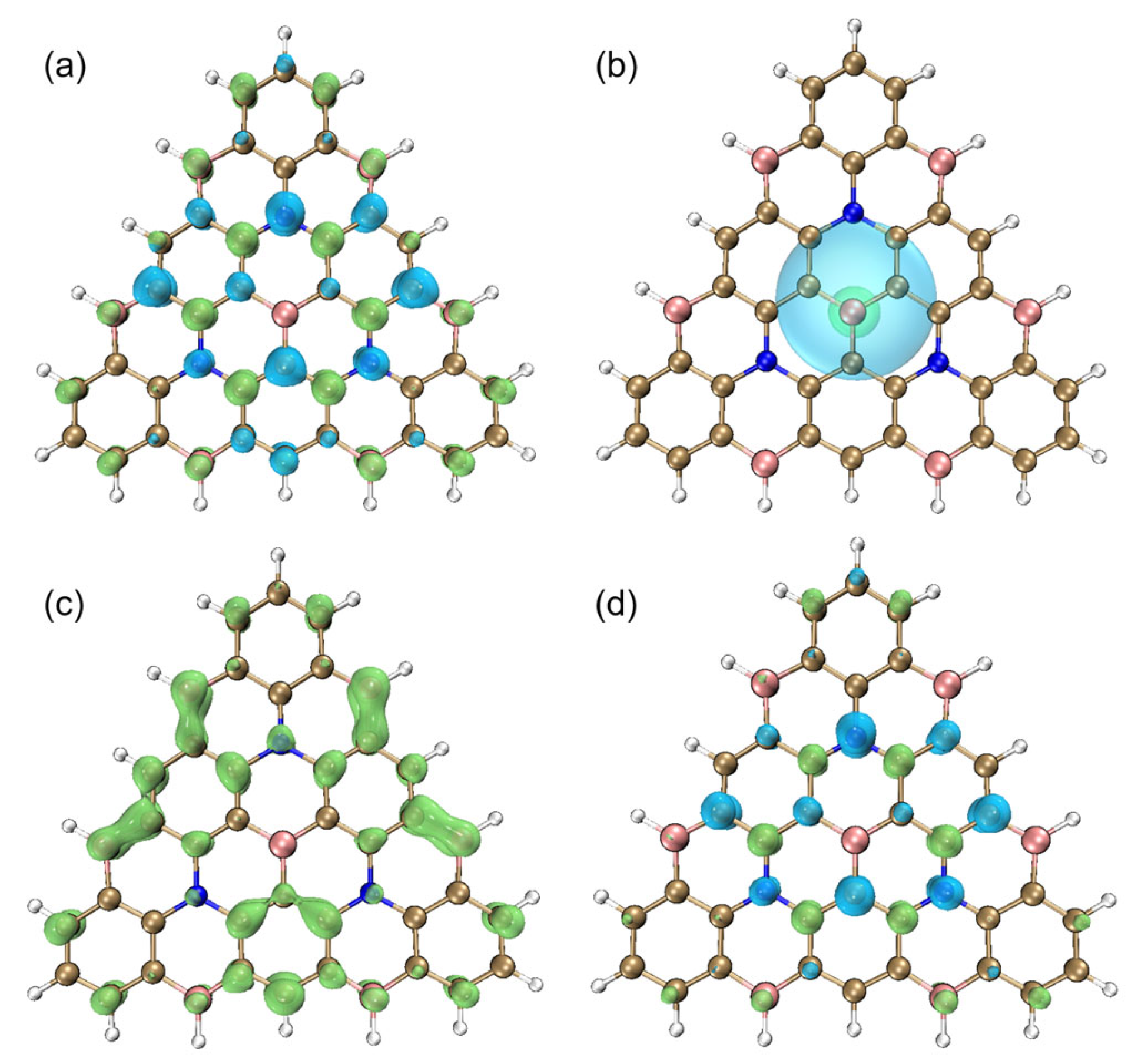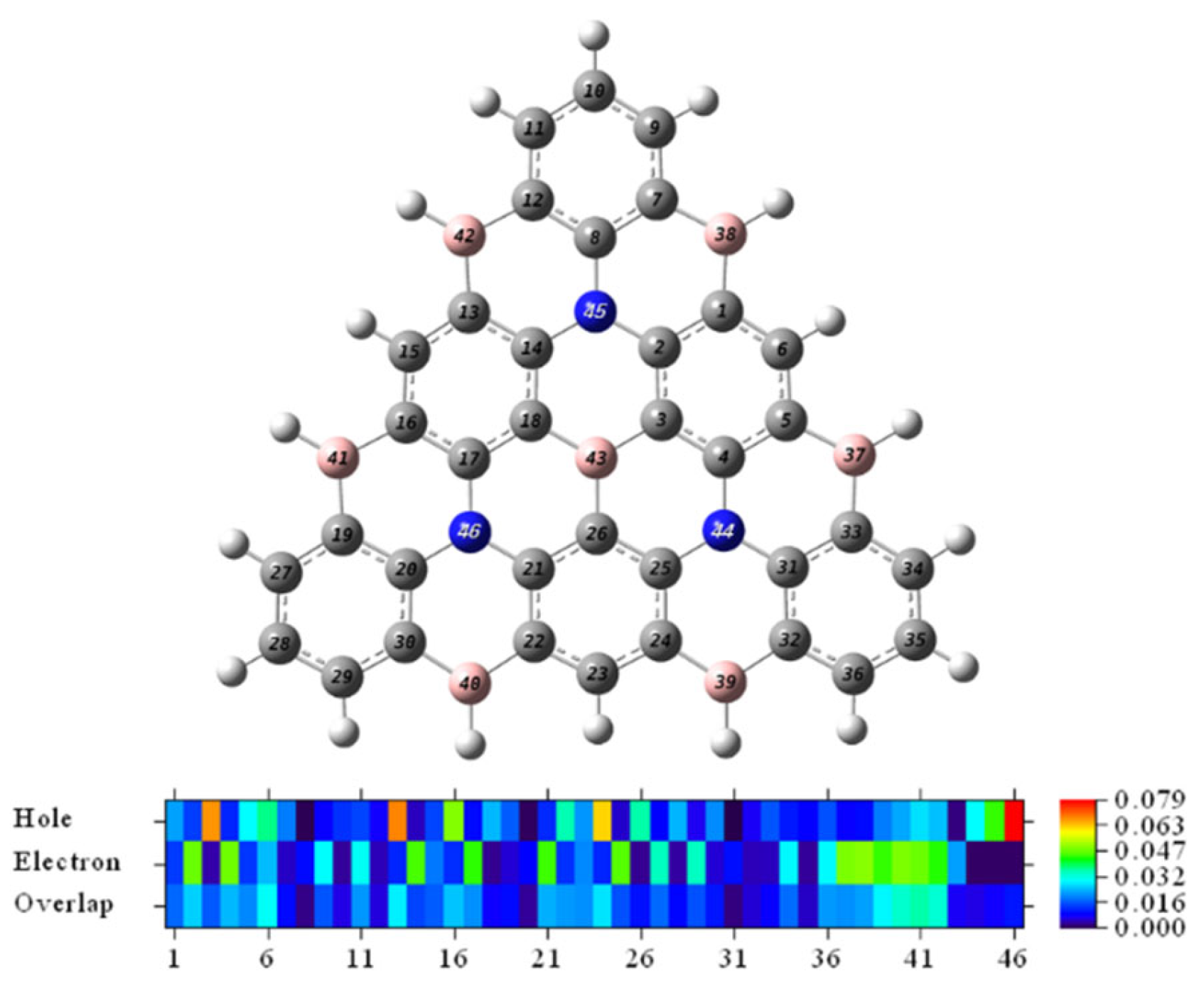Narrowband Deep-Blue Multi-Resonance Induced Thermally Activated Delayed Fluorescence: Insights from the Theoretical Molecular Design
Abstract
:1. Introduction
2. Computational Methods
3. Results and Discussion
3.1. Structure and Spectra
3.2. Hole-Electron Analysis
3.3. Color Tunability over the Spectrum
4. Conclusions
Supplementary Materials
Author Contributions
Funding
Institutional Review Board Statement
Informed Consent Statement
Data Availability Statement
Conflicts of Interest
Sample Availability
References
- Tang, C.W.; VanSlyke, S.A. Organic electroluminescent diodes. Appl. Phys. Lett. 1987, 51, 913. [Google Scholar] [CrossRef]
- Kido, J.; Kimura, M.; Nagai, K. Multilayer white light-emitting organic electroluminescent device. Science 1995, 267, 1332–1334. [Google Scholar] [CrossRef] [Green Version]
- D’Andrade, B.W.; Forrest, S.R. White Organic Light-Emitting Devices for Solid-State Lighting. Adv. Mater. 2004, 16, 1585–1595. [Google Scholar] [CrossRef]
- Ko, C.W.; Tao, Y.T. Bright white organic light-emitting diode. Appl. Phys. Lett. 2001, 79, 4234–4236. [Google Scholar] [CrossRef]
- Jankus, V.; Chiang, C.-J.; Dias, F.; Monkman, A.P. Deep Blue Exciplex Organic Light-Emitting Diodes with Enhanced Efficiency; P-type or E-type Triplet Conversion to Singlet Excitons. Adv. Mater. 2013, 25, 1455–1459. [Google Scholar] [CrossRef] [PubMed] [Green Version]
- Adachi, C.; Baldo, M.A.; Thompson, M.E.; Forrest, S.R. Nearly 100% internal phosphorescence efficiency in an organic light-emitting device. J. Appl. Phys. 2001, 90, 5048–5051. [Google Scholar] [CrossRef] [Green Version]
- Yook, K.S.; Lee, J.Y. Organic Materials for Deep Blue Phosphorescent Organic Light-Emitting Diodes. Adv. Mater. 2012, 24, 3169–3190. [Google Scholar] [CrossRef]
- Zhao, C.; Duan, L. Review on photo- and electrical aging mechanisms for neutral excitons and ions in organic light-emitting diodes. J. Mater. Chem. C 2020, 8, 803–820. [Google Scholar] [CrossRef]
- Endo, A.; Ogasawara, M.; Takahashi, A.; Yokoyama, D.; Kato, Y.; Adachi, C. Thermally activated delayed fluorescence from Sn(4+)-porphyrin complexes and their application to organic light emitting diodes--a novel mechanism for electroluminescence. Adv. Mater. 2009, 21, 4802–4806. [Google Scholar] [CrossRef]
- Zhang, Q.; Li, J.; Shizu, K.; Huang, S.; Hirata, S.; Miyazaki, H.; Adachi, C. Design of Efficient Thermally Activated Delayed Fluorescence Materials for Pure Blue Organic Light Emitting Diodes. J. Am. Chem. Soc. 2012, 134, 14706–14709. [Google Scholar] [CrossRef]
- Yoshida, K.; Matsushima, T.; Nakanotani, H.; Adachi, C. Quantification of temperature rise in unipolar organic conductors during short voltage-pulse excitation using electrical testing methods. Org. Electron. 2016, 31, 191–197. [Google Scholar] [CrossRef]
- Zhao, C.; Zhao, F.; Wang, K.; Yu, H.; Huang, T.; Wang, R.; Zhang, C.; Hu, B.; Duan, L. Stabilization of blue emitters with thermally activated delayed fluorescence by the steric effect: A case study by means of magnetic field effects. Phys. Rev. Appl. 2020, 14, 034059. [Google Scholar] [CrossRef]
- Uoyama, H.; Goushi, K.; Shizu, K.; Nomura, H.; Adachi, C. Highly efficient organic light-emitting diodes from delayed fluorescence. Nature 2012, 492, 234–238. [Google Scholar] [CrossRef] [PubMed]
- Madayanad Suresh, S.; Hall, D.; Beljonne, D.; Olivier, Y.; Zysman-Colman, E. Multiresonant Thermally Activated Delayed Fluorescence Emitters Based on Heteroatom-Doped Nanographenes: Recent Advances and Prospects for Organic Light-Emitting Diodes. Adv. Funct. Mater. 2020, 30, 1908677. [Google Scholar] [CrossRef]
- Osawa, F.; Marumoto, K. Operando direct observation of spin-states and charge-trappings of blue light-emitting-diode materials in thin-film devices. Sci. Rep. 2020, 10, 18800. [Google Scholar] [CrossRef]
- Hatakeyama, T.; Shiren, K.; Nakajima, K.; Nomura, S.; Nakatsuka, S.; Kinoshita, K.; Ni, J.; Ono, Y.; Ikuta, T. Ultrapure Blue Thermally Activated Delayed Fluorescence Molecules: Efficient HOMO-LUMO Separation by the Multiple Resonance Effect. Adv. Mater. 2016, 28, 2777–2781. [Google Scholar] [CrossRef] [PubMed]
- Kondo, Y.; Yoshiura, K.; Kitera, S.; Nishi, H.; Oda, S.; Gotoh, H.; Sasada, Y.; Yanai, M.; Hatakeyama, T. Narrowband deep-blue organic light-emitting diode featuring an organoboron-based emitter. Nat. Photonics 2019, 13, 678–682. [Google Scholar] [CrossRef]
- Liang, X.; Yan, Z.P.; Han, H.B.; Wu, Z.G.; Zheng, Y.X.; Meng, H.; Zuo, J.L.; Huang, W. Peripheral Amplification of Multi-Resonance Induced Thermally Activated Delayed Fluorescence for Highly Efficient OLEDs. Angew. Chem. Int. Ed. Engl. 2018, 57, 11316–11320. [Google Scholar] [CrossRef] [PubMed]
- Nakatsuka, S.; Gotoh, H.; Kinoshita, K.; Yasuda, N.; Hatakeyama, T. Divergent Synthesis of Heteroatom-Centered 4,8,12-Triazatriangulenes. Angew. Chem. Int. Ed. Engl. 2017, 56, 5087–5090. [Google Scholar] [CrossRef] [PubMed]
- Oda, S.; Kawakami, B.; Kawasumi, R.; Okita, R.; Hatakeyama, T. Multiple Resonance Effect-Induced Sky-Blue Thermally Activated Delayed Fluorescence with a Narrow Emission Band. Org. Lett. 2019, 21, 9311–9314. [Google Scholar] [CrossRef]
- Suresh, S.M.; Duda, E.; Hall, D.; Yao, Z.; Bagnich, S.; Slawin, A.M.Z.; Bassler, H.; Beljonne, D.; Buck, M.; Olivier, Y.; et al. A Deep Blue B,N-Doped Heptacene Emitter That Shows Both Thermally Activated Delayed Fluorescence and Delayed Fluorescence by Triplet-Triplet Annihilation. J. Am. Chem. Soc. 2020, 142, 6588–6599. [Google Scholar] [CrossRef]
- Kitamoto, Y.; Suzuki, T.; Miyata, Y.; Kita, H.; Funaki, K.; Oi, S. The first synthesis and X-ray crystallographic analysis of an oxygen-bridged planarized triphenylborane. Chem. Commun. 2016, 52, 7098–7101. [Google Scholar] [CrossRef] [PubMed]
- Zou, S.N.; Peng, C.C.; Yang, S.Y.; Qu, Y.K.; Yu, Y.J.; Chen, X.; Jiang, Z.Q.; Liao, L.S. Fully Bridged Triphenylamine Derivatives as Color-Tunable Thermally Activated Delayed Fluorescence Emitters. Org. Lett. 2021, 23, 958–962. [Google Scholar] [CrossRef]
- Yuan, Y.; Tang, X.; Du, X.-Y.; Hu, Y.; Yu, Y.-J.; Jiang, Z.-Q.; Liao, L.-S.; Lee, S.-T. The Design of Fused Amine/Carbonyl System for Efficient Thermally Activated Delayed Fluorescence: Novel Multiple Resonance Core and Electron Acceptor. Adv. Opt. Mater. 2019, 7, 1801536. [Google Scholar] [CrossRef]
- Sandoval-Salinas, M.E.; Carreras, A.; Casanova, D. Triangular graphene nanofragments: Open-shell character and doping. Phys. Chem. Chem. Phys. 2019, 21, 9069–9076. [Google Scholar] [CrossRef]
- Sanz-Rodrigo, J.; Ricci, G.; Olivier, Y.; Sancho-Garcia, J.C. Negative Singlet-Triplet Excitation Energy Gap in Triangle-Shaped Molecular Emitters for Efficient Triplet Harvesting. J. Phys. Chem. A. 2021, 125, 513–522. [Google Scholar] [CrossRef] [PubMed]
- Ricci, G.; San-Fabian, E.; Olivier, Y.; Sancho-Garcia, J.C. Singlet-Triplet Excited-State Inversion in Heptazine and Related Molecules: Assessment of TD-DFT and ab initio Methods. Chemphyschem 2021, 22, 553–560. [Google Scholar] [CrossRef]
- Ehrmaier, J.; Rabe, E.J.; Pristash, S.R.; Corp, K.L.; Schlenker, C.W.; Sobolewski, A.L.; Domcke, W. Singlet-Triplet Inversion in Heptazine and in Polymeric Carbon Nitrides. J. Phys. Chem. A 2019, 123, 8099–8108. [Google Scholar] [CrossRef] [PubMed]
- Pios, S.; Huang, X.; Sobolewski, A.L.; Domcke, W. Triangular boron carbon nitrides: An unexplored family of chromophores with unique properties for photocatalysis and optoelectronics. Phys. Chem. Chem. Phys. 2021, 23, 12968–12975. [Google Scholar] [CrossRef]
- Sobolewski, A.L.; Domcke, W. Are Heptazine-Based Organic Light-Emitting Diode Chromophores Thermally Activated Delayed Fluorescence or Inverted Singlet-Triplet Systems. J. Phys. Chem. Lett. 2021, 12, 6852–6860. [Google Scholar] [CrossRef]
- Matsui, K.; Oda, S.; Yoshiura, K.; Nakajima, K.; Yasuda, N.; Hatakeyama, T. One-Shot Multiple Borylation toward BN-Doped Nanographenes. J. Am. Chem. Soc. 2018, 140, 1195–1198. [Google Scholar] [CrossRef]
- Lin, L.; Fan, J.; Cai, L.; Wang, C.-K. Excited state dynamics of new-type thermally activated delayed fluorescence emitters: Theoretical view of light-emitting mechanism. Mol. Phys. 2017, 116, 19–28. [Google Scholar] [CrossRef]
- Northey, T.; Penfold, T.J. The intersystem crossing mechanism of an ultrapure blue organoboron emitter. Org. Electron. 2018, 59, 45–48. [Google Scholar] [CrossRef]
- Pershin, A.; Hall, D.; Lemaur, V.; Sancho-Garcia, J.C.; Muccioli, L.; Zysman-Colman, E.; Beljonne, D.; Olivier, Y. Highly emissive excitons with reduced exchange energy in thermally activated delayed fluorescent molecules. Nat. Commun. 2019, 10, 597. [Google Scholar] [CrossRef] [PubMed]
- Bhattacharyya, K. Can TDDFT render the electronic excited states ordering of Azine derivative A closer investigation with DLPNO-STEOM-CCSD. Chem. Phys. Lett. 2021, 779, 138827. [Google Scholar] [CrossRef]
- Frisch, M.J.; Trucks, G.W.; Schlegel, H.B.; Scuseria, G.E.; Robb, M.A.; Cheeseman, J.R.; Scalmani, G.; Barone, V.; Petersson, G.A.; Nakatsuji, H.; et al. Gaussian 16 Rev C.01; Gaussian Inc.: Wallingford, CT, USA, 2016. [Google Scholar]
- Stephens, P.J.; Devlin, F.J.; Chabalowski, C.F.; Frisch, M.J. Ab Initio Calculation of Vibrational Absorption and Circular Dichroism Spectra Using Density Functional Force Fields. J. Phys. Chem. 1994, 98, 11623–11627. [Google Scholar] [CrossRef]
- Tohru, S.; Uejima, M.; Tanaka, K.; Kaji, H.; Adachi, C. A light-emitting mechanism for organic lightemitting diodes: Molecular design for inverted singlet–triplet structure and symmetry-controlled thermally activated delayed fluorescence. J. Mater. Chem. C 2015, 3, 870–878. [Google Scholar]
- Grimme, S.; Ehrlich, S.; Goerigk, L. Effect of the damping function in dispersion corrected density functional theory. J. Comput. Chem. 2011, 32, 1456–1465. [Google Scholar] [CrossRef]
- Liu, Z.; Lu, T.; Chen, Q. An sp-hybridized all-carboatomic ring, cyclo [18] carbon: Electronic structure, electronic spectrum, and optical nonlinearity. Carbon 2020, 165, 461–467. [Google Scholar] [CrossRef]
- Lu, T.; Chen, F. Multiwfn: A multifunctional wavefunction analyzer. J. Comput. Chem. 2012, 33, 580–592. [Google Scholar] [CrossRef]
- Humphrey, W.; Dalke, A.; Schulten, K. VMD: Visual molecular dynamics. J. Mol. Graph. Model. 1996, 14, 33–38. [Google Scholar] [CrossRef]
- Bahers, T.L.; Adamo, L.; Ciofini, I. A Qualitative Index of Spatial Extent in Charge-Transfer Excitations. J. Chem. Theory. Comput. 2011, 7, 2498–2506. [Google Scholar] [CrossRef] [PubMed]







| Compound | Experimental | Calculated | ||
|---|---|---|---|---|
| λ[Abs] (nm) | λ[PL] (nm) | λ[Abs] (nm) | λ[Em] (nm) | |
| DABNA-1 | 437 [16] | 462 [16] | 420 | 459 |
| v-DABNA | 457 [17] | 468 [17] | 458 | 468 |
| B2 | 438 [31] | 462 [31] | 438 | 455 |
| B3 | 396 [31] | 455 [31] | 396 | 441 |
| Core | D (Å) | Sr | H (Å) | T (Å) | HDI | EDI | Orbital Contribution | |
|---|---|---|---|---|---|---|---|---|
| Hole | Electron | |||||||
| Core1 | 1.71 | 0.63 | 3.20 | −0.31 | 7.74 | 5.81 | MO70: 97.76% | MO71: 97.21% |
| Core2 | 0.558 | 0.62 | 4.56 | −1.63 | 5.55 | 4.79 | MO119: 97.98% | MO120: 97.89% |
| Core3 | 0.356 | 0.78 | 4.55 | −2.81 | 4.43 | 3.78 | MO145: 76.51% | MO146: 76.93% |
| MO144: 22.19% | MO147: 21.87% | |||||||
| Compound | ∆EST [CALC] (eV) | ∆EST [EXP] (eV) | |
|---|---|---|---|
| Vertical Energy | Adiabatic Energy | ||
| DABNA-1 | 0.43 | 0.31 | 0.18 [16] |
| ν-DABNA | 0.27 | 0.23 | 0.017 [17] |
| Core3 | 0.29 | 0.24 | - |
| Core3-2F | 0.27 | 0.21 | - |
| Core3-4F | 0.22 | 0.21 | - |
| Core3-CF3 | 0.29 | 0.23 | - |
| Core3-CZ | 0.29 | 0.32 | - |
Publisher’s Note: MDPI stays neutral with regard to jurisdictional claims in published maps and institutional affiliations. |
© 2022 by the authors. Licensee MDPI, Basel, Switzerland. This article is an open access article distributed under the terms and conditions of the Creative Commons Attribution (CC BY) license (https://creativecommons.org/licenses/by/4.0/).
Share and Cite
Wu, Y.; Zhu, Y.; Zhang, Z.; Zhao, C.; He, J.; Yan, C.; Meng, H. Narrowband Deep-Blue Multi-Resonance Induced Thermally Activated Delayed Fluorescence: Insights from the Theoretical Molecular Design. Molecules 2022, 27, 348. https://doi.org/10.3390/molecules27020348
Wu Y, Zhu Y, Zhang Z, Zhao C, He J, Yan C, Meng H. Narrowband Deep-Blue Multi-Resonance Induced Thermally Activated Delayed Fluorescence: Insights from the Theoretical Molecular Design. Molecules. 2022; 27(2):348. https://doi.org/10.3390/molecules27020348
Chicago/Turabian StyleWu, Yuting, Yanan Zhu, Zewei Zhang, Chongguang Zhao, Junpeng He, Chaoyi Yan, and Hong Meng. 2022. "Narrowband Deep-Blue Multi-Resonance Induced Thermally Activated Delayed Fluorescence: Insights from the Theoretical Molecular Design" Molecules 27, no. 2: 348. https://doi.org/10.3390/molecules27020348
APA StyleWu, Y., Zhu, Y., Zhang, Z., Zhao, C., He, J., Yan, C., & Meng, H. (2022). Narrowband Deep-Blue Multi-Resonance Induced Thermally Activated Delayed Fluorescence: Insights from the Theoretical Molecular Design. Molecules, 27(2), 348. https://doi.org/10.3390/molecules27020348







